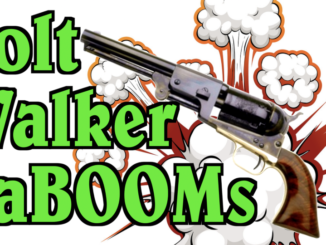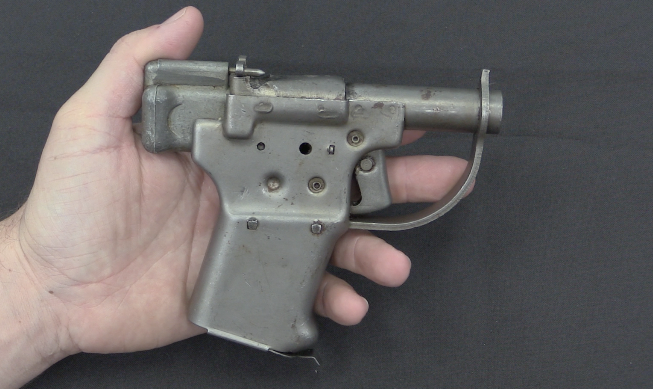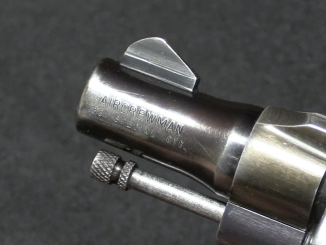This 1874 Sharps rifle is a great example of a been-there, done-that authentic western buffalo rifle. It was shipped from Sharps in 1879 with double set triggers, open sights, and a medium-weight .45 caliber barrel, but rebuilt by a Cheyenne gunsmith with a much heavier barrel in .40-100 caliber, and fitted with a Rice telescopic sight in a free-floating mount. While this was built just too late to have been used in the heyday of the slaughter of the wild buffalo, it is a fine example of the rifle configuration used by serious hunters and target shooters alike at that time.
Related Articles

Antiques
Why The Most Expensive US Martial Pistol Exploded A Lot
The Colt Model 1847 Walker is one of the most valuable of all US military handguns in the collecting community, with examples sometimes breaking seven figures. However, the Walker was in many ways a remarkable […]

Handgun
FP-45 Liberator at RIA
The Liberator is one of those interesting artifacts of WWII; an extremely simple single-shot .45 caliber pistol made by the boxcar-load (a million, specifically) with the intention of being dropped en masse across Europe to […]

Revolver
Colt M13 Aircrewman Revolver: So Light it was Unsafe
In 1951 and 1952, Colt supplied a small number of extremely lightweight revolvers to the US Air Force, designated the M13 Aircrewman. These guns were very similar to the commercial Colt Cobra; .38 special 6-shot […]

I need to watch Quigley Down Under again, and read the story of Adobe Walls Great video, wish I could afford this piece of history.
There’re .45-100 Sharps Straight 2 7/8″ (11.4x73R) and .45-100 Ballard (11.4x72R) – and .40-90 Sharps Straight 3 1/4″ (10.2x82R) and .40-90 Sharps Necked (10x67R).
But what’s .40-100?
“But what’s .40-100?”
According to http://www.chuckhawks.com/buffalo_cartridges.htm
“(…)The .40-90 and .40-100 (Necked) were the same cartridge with different powder charges and bullets.(…).40-90 factory loads drove a 370 grain lead bullet at a MV of 1475 fps(…)[.40-100] used a lighter 190 grain hollow point bullet in front of extra powder to achieve a higher MV at the expense of penetration on large game.”
I feel sorry for the bison. The problem with commercial hunting is depopulation to the point where intended game is no longer sustainable. But back to the rifle. Could this falling-block action work with smokeless powder or express cartridges? And just how much brick wall would be needed to stop .40-100 from 500 yards away?
Yes. This design is still in production, and some use black powder, some use smokeless. As long as prudent loads are utilized, smokeless is fine.
That front scope mount looks like a modified rear sight.
Looks like the front mount is made from a rear barrel sight. Am I seeing that right?
Buffalo leather.
One product of the buffalo trade that not many know about is the use of buffalo leather. In old photos of period factories, often you’ll see a overhead rotating shaft which powers various machines via long belts. Those belts were often buffalo leather; it had good qualities for such a purpose.
Wish I’d had the money several years ago. One of my LGS had what was claimed to be an early bench rest rifle available for around 7 grand. Built in 1880’s, 45-70 falling block, original scope and and a 36″ 2 1/2″ round Bull barrel. Whole thing went 60+ lbs. It was described
Pewabic Pottery here in Detroit was built in 1907. It’s still in business, using all period equipment. As recently as ~10 years ago, the main power belt in the production workshop was still made of buffalo hide.
I myself do not care much about shotguns, but this 4-barrel is cool as feck.
I must disregard my personal opinion for shotguns and compliment Ian for making high quality and informative video.
Some would say that I am PRO Ian. 🙂
‘Twas in the town of Sioux City,
In the summer of ’73,
When a man by the name of Krego
Came steppin’ up to me,
Sayin’,
“How do you do, young feller,
And how would you like to go
And spend one summer pleasantly
On the range of the buffalo?”
Cool video, but the origin of the term “Sharpshooter” wasn’t American: a term borrowed from German in Britain and used there much more extensively before being adopted in the states.
https://www.worldwidewords.org/qa-sha5.html#:~:text=But%20the%20term%20sharp%20shooter,force%20using%20the%20Baker%20rifle.